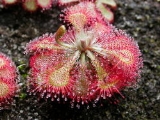
Sundew
Overview
Drosera, commonly known as the sundews, comprise one of the largest genera
of carnivorous plant
s, with at least 194 species
. These members of the family Droseraceae
lure, capture, and digest insects using stalked mucilaginous
glands covering their leaf surface. The insects are used to supplement the poor mineral nutrition of the soil in which they grow. Various species, which vary greatly in size and form, can be found growing natively on every continent except Antarctica.
Both the botanical name (from the Greek
δρόσος: "drosos" = "dew, dewdrops") as well as the English common name (sundew, derived from Latin
ros solis, meaning "dew of the sun") refer to the glistening drops of mucilage
at the tip of each tentacle
that resemble drops of morning dew
.
Sundews are perennial
(or rarely annual
) herbaceous plant
s, forming prostrate or upright rosettes between 1 centimeter (0.4 in) and 1 meter (39 in) in height, depending on the species.
Genus
In biology, a genus is a low-level taxonomic rank used in the biological classification of living and fossil organisms, which is an example of definition by genus and differentia...
of carnivorous plant
Carnivorous plant
Carnivorous plants are plants that derive some or most of their nutrients from trapping and consuming animals or protozoans, typically insects and other arthropods. Carnivorous plants appear adapted to grow in places where the soil is thin or poor in nutrients, especially nitrogen, such as acidic...
s, with at least 194 species
Species
In biology, a species is one of the basic units of biological classification and a taxonomic rank. A species is often defined as a group of organisms capable of interbreeding and producing fertile offspring. While in many cases this definition is adequate, more precise or differing measures are...
. These members of the family Droseraceae
Droseraceae
Droseraceae is the botanical name for a family of flowering plants. The family is also known under its common name, the sundew family.It consists of carnivorous plants: besides the sundews, the genus Drosera, it also contains the even more-famous Venus fly trap Dionaea muscipula...
lure, capture, and digest insects using stalked mucilaginous
Mucilage
Mucilage is a thick, gluey substance produced by most plants and some microorganisms. It is a polar glycoprotein and an exopolysaccharide.It occurs in various parts of nearly all classes of plant, usually in relatively small percentages, and is frequently associated with other substances, such as...
glands covering their leaf surface. The insects are used to supplement the poor mineral nutrition of the soil in which they grow. Various species, which vary greatly in size and form, can be found growing natively on every continent except Antarctica.
Both the botanical name (from the Greek
Ancient Greek
Ancient Greek is the stage of the Greek language in the periods spanning the times c. 9th–6th centuries BC, , c. 5th–4th centuries BC , and the c. 3rd century BC – 6th century AD of ancient Greece and the ancient world; being predated in the 2nd millennium BC by Mycenaean Greek...
δρόσος: "drosos" = "dew, dewdrops") as well as the English common name (sundew, derived from Latin
Latin
Latin is an Italic language originally spoken in Latium and Ancient Rome. It, along with most European languages, is a descendant of the ancient Proto-Indo-European language. Although it is considered a dead language, a number of scholars and members of the Christian clergy speak it fluently, and...
ros solis, meaning "dew of the sun") refer to the glistening drops of mucilage
Mucilage
Mucilage is a thick, gluey substance produced by most plants and some microorganisms. It is a polar glycoprotein and an exopolysaccharide.It occurs in various parts of nearly all classes of plant, usually in relatively small percentages, and is frequently associated with other substances, such as...
at the tip of each tentacle
Tentacle
A tentacle or bothrium is one of usually two or more elongated flexible organs present in animals, especially invertebrates. The term may also refer to the hairs of the leaves of some insectivorous plants. Usually, tentacles are used for feeding, feeling and grasping. Anatomically, they work like...
that resemble drops of morning dew
Dew
[Image:Dew on a flower.jpg|right|220px|thumb|Some dew on an iris in Sequoia National Park]]Dew is water in the form of droplets that appears on thin, exposed objects in the morning or evening...
.
Sundews are perennial
Perennial plant
A perennial plant or simply perennial is a plant that lives for more than two years. The term is often used to differentiate a plant from shorter lived annuals and biennials. The term is sometimes misused by commercial gardeners or horticulturalists to describe only herbaceous perennials...
(or rarely annual
Annual plant
An annual plant is a plant that usually germinates, flowers, and dies in a year or season. True annuals will only live longer than a year if they are prevented from setting seed...
) herbaceous plant
Herbaceous plant
A herbaceous plant is a plant that has leaves and stems that die down at the end of the growing season to the soil level. They have no persistent woody stem above ground...
s, forming prostrate or upright rosettes between 1 centimeter (0.4 in) and 1 meter (39 in) in height, depending on the species.
Discussions

